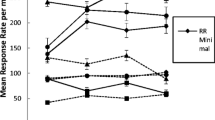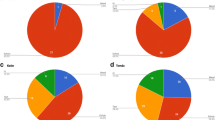Abstract
The purpose of this study was to ascertain the motivational effects of positive verbal reinforcement on the performance of a qualitative task. Male subjects performed on a task consisting of 24 slides that allowed them to test their decision-making abilities in simulated situations. Subjects performed under one of five noncontingent verbal reinforcement ratios (.00, .25, .50, .75, or 1.00). Subjects' accuracy and reaction times to each of the 24 slide stimuli were recorded and transformed into a total performance index. In line with an inverted-U hypothesis, it was hypothesized that if motivational effects of positive verbal reinforcement exist, they should induce a curvilinear relationship between reinforcement ratio and performance. This hypothesis was supported by the results of a trend analysis that showed that only the quadratic curvilinear term was significant. Inspection of means revealed the presence of an inverted-U curve such that performance gradually increased from ratio 0 and reached a maximum at ratio .50, following which a decrease in performance was obtained for ratios .75 and 1.00. Results support a motivational interpretation of the effects of positive verbal reinforcement on performance. Findings are discussed in light of the interaction between motivational and attentional processes.
Similar content being viewed by others
References
Bahrick, H. P., Fitts, P. M., & Rankin, R. E. (1952). Effect of incentives upon reactions to peripheral stimuli.Journal of Experimental Psychology, 44 400–406.
Baron, R. M. (1966). Social reinforcement effects as a function of social reinforcement history.Psychological Review, 73 527–539.
Easterbrook, J. A. (1959). The effect of emotion on cue utilization and the organization of behavior.Psychological Review, 6 183–201.
Elliot, R. (1969). Tonic heart rate: Experiments on the effects of collative variable leads to a hypothesis about its motivational significance.Journal of Personality and Social Psychology, 12 211–228.
Evans, J. F. (1972). Resting heart rate and the effects of an incentive.Psychonomic Science, 26 99–100.
Fowles, D. C., Fisher, A. E., & Trand, D. T. (1982). The heart beats to reward: The effect of monetary incentive on heart rate.Psychophysiology, 19 506–513.
Gill, D. L., & Martens, R. (1975). The informational and motivational influence of social reinforcement on motor performance.Journal of Motor Behavior, 7 171–182.
Gross, J. B., & Gill, D. L. (1982).Competition and instructional set effects on the speed and accuracy of a throwing task.Research Quarterly for Exercise and Sport, 53 125–132.
Hill, K. T., & Stevenson, H. W. (1965). The effects of social reinforcement versus non reinforcement and sex of experimenter on the performance of adolescent girls.Journal of Personality, 33 30–36.
Hrycaiko, D. W. (1978). The effects of competition and social reinforcement upon perceptual motor performance.Journal of Motor Behavior, 10, 159–168.
Hutchison, S., & Lair, C. V. (1971). Influence of drive level on various feedback combinations.Psychological Reports, 29 1191–1195.
Kirschenbaum, D. S., & Smith, R. J. (1983). A preliminary study of sequencing effects in simulated coach feedback.Journal of Sport Psychology, 5 332–342.
Landers, D. M. (1978). Motivation and performance: The role of arousal and attentional factors. In W. F. Straub (Ed.),Sport psychology: An analysis of athlete behavior (1st ed., pp. 74–85). Ithaca, New York: Mouvement.
Maehr, M. L. (1967, February).Competence revisited. Paper presented at the annual meeting of the American Educational Research Association, Boston.
Martens, R. (1970). Social reinforcement effects on preschool children's motor performance.Perceptual and Motor Skills, 31 787–792.
Martens, R. (1972). Social reinforcement effects as a function of socio-economic status.Perceptual and Motor Skills, 35 215–218.
Martens, R. (1975).Social psychology and physical activity. New York: Harper & Row.
Martens, R., Burwitz, L., & Newell, K. (1972). Money and praise: Do they improve motor learning and performance.Research Quarterly, 43 429–442.
McCaughan, L. R. (1983). Effects of achievement motivation and success/failure on attributions, expectancies, and performance on a psychomotor task.Perceptual and Motor Skills, 56 901–902.
McCaughan, L. R., & Gimbert, B. (1981). Social reinforcement as a determinant of performance, performance expectancy, and attributions.Journal of Motor Behavior, 13 91–101.
Roberts, G. C., & Martens, R. (1970). Social reinforcement and complex motor performance.Research Quarterly, 41 175–181.
Spielberger, C. D. (1966). Theory and research in anxiety. In C. D. Spielberger (Ed.),Anxiety and behavior (pp. 3–20). New York: Academic Press.
Stock, C. G. (1978). Effects of praise and its source on performance.Perceptual and Motor Skills, 47 43–46.
Terrell, G., & Kennedy, W. A. (1957). Discrimination learning and transposition as a function of the nature of the reward.Journal of Experimental Psychology, 53 257–260.
Thiffault, C. (1980). Construction et validation d'une mesure de la rapidité de la pensée tactique des joueurs de hockey sur glace. In C. H. Nadeau, W. R. Halliwell, K. Newell, & G. C. Roberts (Eds.),Psychology of motor behavior and sport-1979 (pp. 643–649). Champaign, Illinois: Human Kinetics.
Wankel, L. M. (1975). The effects of social reinforcement and audience presence upon the motor performance of boys with different levels of initial ability.Journal of Motor Behavior, 7 207–216.
Author information
Authors and Affiliations
Additional information
This manuscript was prepared while the author was supported by grants from the Social Sciences and Humanities Research Council of Canada, the Conseil Québécois de la Recherche Sociale, le Fond pour la Formation des Chercheurs et l'Aide à la Recherche (FCAR-Québec), and the Université du Québec à Montréal. I would like to thank Roy Baumeister and Luc Pelletier for their comments on an earlier draft of this article, and Charles Thiffault for allowing me to use the hockey-slide task in this study.
Rights and permissions
About this article
Cite this article
Vallerand, R.J. On the motivational effects of positive verbal reinforcement on performance: Toward an inverted-U relationship. Motiv Emot 11, 367–378 (1987). https://doi.org/10.1007/BF00992850
Issue Date:
DOI: https://doi.org/10.1007/BF00992850




